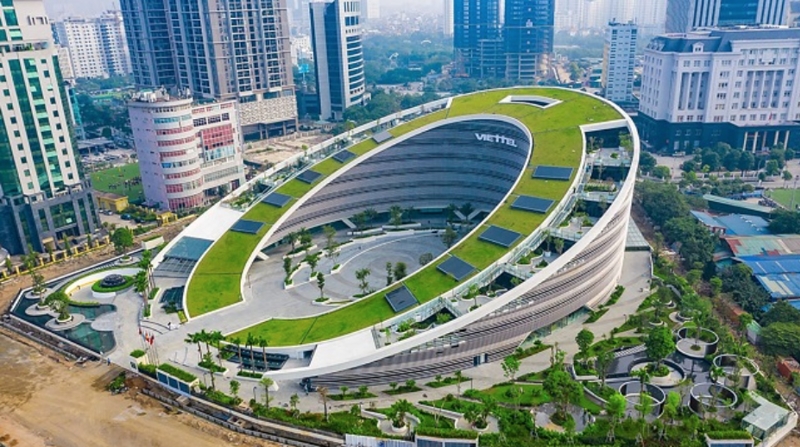As climate change becomes an undeniable reality and global commitments to sustainable development grow more urgent, transitioning to a green industrial model is no longer a choice but a necessary step to secure a prosperous and resilient future for Vietnam. Strategic shifts in policy and investment are powerful engines for boosting national competitiveness, improving quality of life, and turning sustainability goals into tangible results.
Laying the groundwork
Fully aware of the importance of sustainable development, the Party and the State has issued a comprehensive set of strategic guidelines and policies. In Resolution No. 29-NQ/TW dated November 17, 2022, the 13th Central Committee of the Communist Party of Vietnam identified digital transformation and green transition as core pillars of the country’s industrialization and modernization process for the 2021-2030 period with a vision to 2045.
Decision No. 1658/QD-TTg, issued by the Prime Minister on October 1, 2021, approved the National Green Growth Strategy for 2021-2030 and Vision towards 2050. The strategy sets out goals to reduce greenhouse gas emissions intensity per unit of GDP, to “green” key economic sectors, and to promote the circular economy.
Additionally, Decision No. 687/QD-TTg, dated June 7, 2022, approved the “Scheme for Circular Economy Development in Vietnam”, aiming to reduce greenhouse gas emissions intensity by at least 15 per cent by 2030 compared to 2014 and to work towards achieving net-zero emissions by 2050.
Notably, the Prime Minister’s strong commitment at COP26 in 2021 to reach net-zero emissions by 2050 marked a turning point, creating significant momentum for the entire political system and society to take action.
The Law on Environmental Protection 2020 provides a critical legal foundation, introducing for the first time regulations on the circular economy and sustainable production and consumption. The revised National Power Development Plan for 2021-2030 with a Vision to 2050 (revised PDP8), sets clear targets to accelerate the development of renewable energy sources (excluding hydropower) for electricity production, aiming for a share of 28-36 per cent by 2030. By 2050, the share of renewables is projected to reach 74-75 per cent.
In parallel, the government has introduced a range of incentive policies to support businesses in accessing preferential loans, upgrading technologies, and actively participating in the green transition.
Early progress and challenges
Following the implementation of supportive policies, Vietnam’s industrial development has witnessed positive progress. According to the Ministry of Industry and Trade, industry has consistently accounted for over 30 per cent of national GDP during the 2020-2025 period. Within this, the manufacturing and processing industry remained the primary growth engine, making up approximately 80 per cent of the industrial structure. Vietnam has gradually asserted its position as one of Asia’s manufacturing hubs and has been recognized by the United Nations Industrial Development Organization (UNIDO) as part of the group of middle-income industrial economies.
From 2021 to 2025, the country’s industrial sector has continued to expand, with the Index of Industrial Production (IIP) rising at an average annual rate of some 6.3 per cent. In particular, the manufacturing and processing industry is expected to grow by roughly 7.1 per cent per year, maintaining its role as the main driver of industrial growth. Its contribution to total industrial output is projected to increase from 77.2 per cent in 2021 to around 80 per cent by 2025, and it accounts for nearly 85 per cent of total exports. The industrial sector’s average growth rate remains higher than the GDP growth rate. Its internal structure has also improved, with a gradual decline in mining and a robust rise in energy, manufacturing, and processing industries.
At the same time, the energy sector has undergone a positive structural shift, notably with the rapid development of renewable energy. By 2024, renewable energy accounted for 26.8 per cent of the country’s total installed capacity and 13.4 per cent of the primary energy supply. This has not only helped stabilize electricity supply for industrial production but also driven the sector’s evolution towards green industry.
Despite these encouraging results, the Ministry of Industry and Trade acknowledges several persistent challenges in Vietnam’s industrialization process. Specifically, though the manufacturing and processing industry has been identified as the engine of economic growth, its current technological level remains significantly behind that of a modern industrialized country. Many enterprises still rely on outdated technologies, resulting in inefficiency and environmental harm, and the industry’s competitiveness remains weak compared to regional peers. With a highly open economy, Vietnam’s manufacturing sector remains heavily reliant on imports, making it vulnerable to fluctuations in the global market.
Furthermore, domestic support industries remain underdeveloped, leading to a heavy dependence on imported components and raw materials. As a result, Vietnamese manufacturing enterprises often participate only in the lower value-added segments of the supply chain, such as assembly. Localization rates remain low across many products.
Leveraging momentum
While facing many challenges, several economic experts believe that Vietnam still has opportunities and momentum to accelerate the green transformation of its industrial sector. Major export markets such as the EU are increasingly imposing stricter environmental standards, such as the Carbon Border Adjustment Mechanism (CBAM), the Emissions Trading System (ETS), and renewable energy regulations, pressuring Vietnamese enterprises to adapt in order to remain competitive.
Importantly, a green transition also presents an opportunity to attract high-quality FDI, particularly in green technologies and renewable energy. At the recent “Asia-Europe Industry Cooperation Forum”, organized by the Vietnam Association of Foreign-Invested Enterprises (VAFIE), a representative from the Foreign Investment Agency at the Ministry of Finance affirmed that Vietnam is increasingly positioning itself as a vital link in regional and global supply chains. FDI inflows from Europe have been rising rapidly, with impressive growth from the UK (up 172 per cent), Poland (up 1,000 per cent), and Luxembourg (up 1,100 per cent). This reflects the positive impact of next-generation free trade agreements (FTAs) such as the EU-Vietnam Free Trade Agreement (EUVFTA) and the Comprehensive and Progressive Agreement for Trans-Pacific Partnership (CPTPP).
In its FDI attraction strategy for the coming period, Vietnam has made clear its intent to pursue selective investment, with a focus on quality, efficiency, innovation, and sustainable development. The government is encouraging projects that incorporate high technology, deliver substantial added value, generate positive spillover effects, engage with domestic enterprises, and are environmentally friendly. Key priority sectors include high-tech industries, semiconductors, renewable energy (LNG, hydrogen, and battery technology), logistics, industrial infrastructure, innovation, and digital transformation.
Turning green challenges into opportunities
To navigate growing challenges and seize the momentum of green transformation, experts emphasize the need for coordinated, forward-looking strategies.
The first step is to review and strengthen legal and policy frameworks for green growth, ensuring consistency and practical enforcement. Green goals should be integrated into sectoral and local development plans. At the same time, Vietnam should promote green finance, through green credit, green bonds, and sustainable investment funds, to mobilize resources. The government must offer incentives, financial support, and risk-sharing mechanisms, particularly in the early phases of green investment.
Building enterprise capacity and a skilled workforce is equally crucial. Businesses should be encouraged to invest in clean technology and innovation. Workforce development should focus on green skills, environmental management, and renewable energy. Stronger collaboration between public and private sectors can help form green supply chains and support circular economy models.
Vietnam should also deepen its engagement in global sustainability initiatives and attract international capital, technology, and expertise to accelerate its transition.
Ultimately, green industrial development is a transformative journey, demanding political will, societal alignment, and business leadership. Though challenging, this path offers Vietnam the opportunity to address climate and environmental issues, boost competitiveness, and shape a prosperous, sustainable future. A successful green transformation will be a defining milestone in the country’s development journey.









 Google translate
Google translate